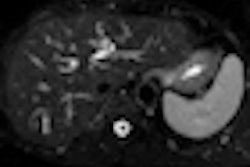FDG-PET's ability to assess metabolic tumors appears to be a valuable asset in determining the biology of colorectal liver metastases (CRLM) before surgical resection and may better evaluate patient prognosis, according to a study in the September issue of the Journal of Nuclear Medicine.
Australian researchers found that certain quantitative FDG-PET measurements have the prognostic potential to guide physicians in their selection of therapy to improve outcomes for patients with CRLM. More specifically, the researchers found that higher levels of metabolic tumor volume and tumor glycolytic value indicated poorer patient prognosis, especially compared to two other FDG-PET parameters, maximum and mean standardized uptake values (SUVs).
The lead author of the study was Dr. Vijayaragavan Muralidharan from Austin Hospital and the University of Melbourne (JNM, September 1, 2012, Vol. 53:9, pp. 1345-1351).
PET's staging prowess
Treatment for colorectal liver metastases with surgical resection and chemotherapy can result in five-year survival rates of 30% to 50%, the authors wrote. However, previous studies have also shown that despite the benefits of the treatment, surgical resection can be offered only to 20% to 30% of patients because many patients with the disease are unfit for major surgery.
Over the years, PET has been used to stage colorectal liver metastases, given the modality's prowess in assessing tumor functional and metabolic processes. Recent studies also have found a correlation between high FDG uptake in tumors and poor patient survival in cases of lung, breast, head and neck, and esophageal cancers.
"Despite growing interest in the biology of tumors as a predictor of outcome, there is a general lack of tools to assess tumor biology in CRLM," the authors noted.
Researchers used the Austin Hospital database to identify patients who were admitted for surgical resection of CRLM between January 2004 and December 2007. Their criteria included patients who received neoadjuvant chemotherapy before surgery and adjuvant chemotherapy after surgery, as well as subjects who had received FDG-PET/CT after completing chemotherapy and immediately before liver surgery.
Patients who underwent FDG-PET/CT fasted for six hours before receiving approximately 5 MBq of FDG per kg of body weight. All patients were scanned from base of skull to upper thighs on a PET/CT system (Philips Healthcare) after an uptake period of 60 minutes. A low-dose CT component was used for attenuation correction and anatomic localization. The duration of the FDG-PET emission scan was three minutes per bed position, and scans were processed with 3D iterative reconstruction.
The researchers calculated overall survival based on the number of months from liver resection until death, and they defined recurrence-free survival as the interval from hepatectomy (surgical resection of the liver) to the first evidence of tumor recurrence found by either PET or CT.
They then gauged survival rates and prognoses based on the efficacy of the four parameters -- maximum and mean standardized uptake value, metabolic tumor volume (MTV), and tumor glycolytic volume (TGV) -- to measure the metabolic activity of tumors.
SUV analysis
Of the 30 FDG-PET/CT scans in the study, there were four cases involving tumors with no observable FDG uptake. In addition, at the time of follow-up, 20 (67%) of the 30 patients were found to have tumor recurrences, with a median overall survival of 58 months, ranging from 42.2 to 73.8 months.
In addition, SUVmean (area under the curve [AUC], 0.531) and SUVmax (AUC, 0.580) were poor predictors of patient mortality at the 30-month follow-up. However, MTV (AUC, 0.760) and TGV (AUC, 0.753) achieved greater predictive capabilities and showed further improvement when only patients with FDG-avid tumors were analyzed (MTV: AUC, 0.886; TGV: AUC, 0.876).
MTV (AUC, 0.804) and TGV (AUC, 0.786) also outperformed SUVmean (AUC, 0.577) and SUVmax (AUC, 0.673) in the ability to predict tumor recurrence.
Based on previous research, Muralidharan and colleagues established cutoff points to maximize sensitivity and specificity of each PET metabolic measurement. Once again, they noted a significant increase in predictability when patients with FDG-avid tumors were analyzed separately.
Threshold levels
An MTV cutoff of 15.58 cm3 achieved 100% sensitivity by correctly identifying all patients who did not survive up to 30 months, while seven of 10 patients below the cutoff point survived to the 30-month follow-up, for specificity of 73%. Similar results were seen with TGV using a cutoff of 64.97 SUV-mL, which achieved sensitivity of 100% and specificity of 76%.
"From our findings, an increase of MTV and TGV by one unit increased the hazard of death by 3.5% and 1%, respectively," Muralidharan and colleagues wrote. "Considering that MTV and TGV measurements ranged by up to 77.31 cm3 and 343.16 SUV-mL, respectively, the survival advantage of patients with a low metabolically active tumor burden appears to be quite substantial."
The authors also noted that although prognostic scores have been fundamental in establishing clinical risk factors for CRLM, they are likely to face significant challenges in the future. Validation of many of these scoring systems in independent patient populations is still limited. Meanwhile, the growing trend toward molecular targeted therapies may require an entirely new repertoire of biomarkers directly related to novel treatments.
A prospective study is currently under way at Austin Hospital to further explore the results.



















